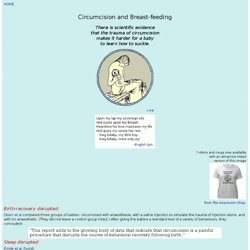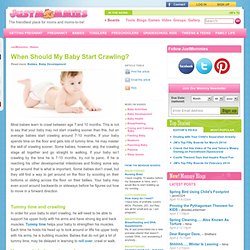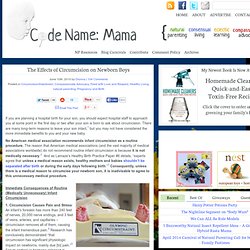

Circumcision and Breast-feeding. Circumcision and Breast-feeding There is scientific evidence that the trauma of circumcision makes it harder for a baby to learn how to suckle.

T-shirts and mugs now available with an attractive tinted version of this image from The Intactivism Shop . Birth-recovery disrupted: Dixon et al compared three groups of babies: circumcised with anaesthesia, with a saline injection to simulate the trauma of injection alone, and with no anaesthetic. Sleep disrupted: Emde et al. found: Behaviour disrupted: Marshall et al. conducted a standard battery of tests (the Brazelton Neonatal Behavioral Assessment Scale, or NBAS) on two groups of babies, one circumcised at two days, the other at three weeks, with the experimenters kept ignorant of the circumcision status of the babies.
Feeding disrupted: Breast-feeding disrupted: The AAP: In December 1997, the American Academy of Pediatrics published a policy on Breast Feeding and the Use of Human Milk which said ...but did not mention circumcision directly. UTIs: Avoiding the Cobra Pose. Circumcision: Echoes in the Body By Jeane Rhodes, Ph.D.

Recently, I completed a doctoral research project in which I investigated the possible link between the way children do selected yoga postures for the first time and their individual birth experiences. The body language of 22 children, five to nine years old, was carefully videotaped and analyzed. To learn about the children's birth experiences I interviewed the parents. After analysis of the data, I was able to identify specific elements in the performance of the yoga postures that could be perceived as clues to the child's prenatal and birth experience.
In the course of this research, I made an unexpected observation related to male circumcision. What I observed was that the seven boys in the study who had been circumcised did not place their hips on the floor when doing an abdominal-lying-arch posture (the "cobra" pose for those of you familiar with yoga postures). Email Dr. When Should My Baby Start Crawling? Most babies learn to crawl between age 7 and 10 months.

This is not to say that your baby may not start crawling sooner than this, but on average babies start crawling around 7-10 months. If your baby spends time on the floor and gets lots of tummy time, he may master the skill of crawling sooner. Some babies, however, skip the crawling stage all together and go straight to walking. If your baby isn’t crawling by the time he is 7-10 months, try not to panic. If he is reaching his other developmental milestones and finding some way to get around that is what is important. Tummy time and crawling In order for your baby to start crawling, he will need to be able to support his upper body with his arms and have strong leg and back muscles.
How your baby learns to crawl Babies often learn to rock back and forth before they start crawling. Safety concerns with crawling babies Tips for helping your baby learn to crawl. The Effects of Circumcision on Newborn Boys. June 10th, 2010 by Dionna | 104 Comments Posted in Circumcision/Intactivism, Compassionate Advocacy, Feed with Love and Respect, Healthy Living, natural parenting, Pregnancy and Birth If you are planning a hospital birth for your son, you should expect hospital staff to approach you at some point in the first day or two after your son is born to ask about circumcision.

There are many long-term reasons to leave your son intact, but you may not have considered the more immediate benefits to you and your new baby. No American medical association recommends infant circumcision as a routine procedure. The reason that American medical associations (and the vast majority of medical associations worldwide) do not recommend routine infant circumcision is because it is not medically necessary. Immediate Consequences of Routine (Medically Unnecessary) Infant Circumcision 1. After circumcision, the penis has a raw, open wound. 2. 3. 4. Circumcision, Breastfeeding, and Maternal Bonding. This index page contains links to documents about circumcision versus breastfeeding, the effect of circumcision on mother-infant bonding and interaction, and information about breastfeeding's beneficial effect on reducing the risk of urinary tract infection (UTI) in infancy.

See also The Birth Scene, a site having an excellent discussion of circumcision in seven articles by leading writers. Circumcision's Adverse Impact on Breastfeeding Initiation Medical authorities agree that there are no medical indications for circumcision in the newborn period. Male neonatal circumcision is a non-therapeutic operation, an unnecessary procedure that does not promote child health. Authorities agree that male circumcision is a painful and distressing event for a baby. The AAP Policy Statement on Breastfeeding documents numerous significant benefits of breastfeeding for both mother and baby.
Library Holdings Medical literature Marshall RE, Stratton WC, Moore JA, and Boxerman SB. Testimonial Letter.